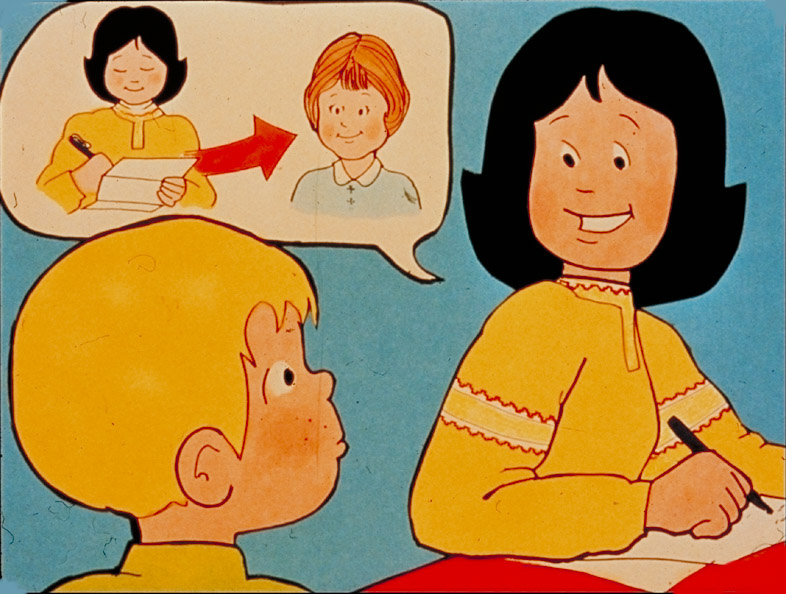
In Lesson 2 you will demonstrate your ability to use sentence patterns and vocabulary which you have learned throughout this course. You will have the opportunity to demonstrate your knowledge of cases, gender and related vocabulary.
Дуже добре! - Very good! This is very good.
|
Іменники: Знахідний Відмінки
Nouns: Accusative Case |
There are no new nouns introduced in Dialogue 10, so you may concentrate your efforts on reviewing what you already know about nouns, cases and sentence patterns.
1 . Subject – Verb – Direct Object
| Я хочу писати листи. |
 |
|
| Я хочу читати журнал. |
 |
|
Study these sentences from the dialogue. Note that the words листи and журнал are used as direct objects of the verbs хочу писати and хочу читати. At this point, it is important for you to see that there are no prepositions in front of each noun. The nouns answer the question Що? as illustrated below.
Я хочу писати що? Я хочу писати листи.
Я хочу читати що? Я хочу читати журнал.
Recall that in previous Units, you were presented with similar sentence patterns.
Я читаю журнал. Я читаю що? Я читаю жунрал.
Я пишу листа . Я пишу що? Я пишу листа .
Ти маєш квитки. Ти маєш що? Ти маєш квитки.
Ти маєш гроші. Ти маєш що? Ти маєш гроші.
By using this questioning pattern, you will have an easy and straightforward way to determine whether a noun which follows a verb is a direct object in the Accusative Case.
2. Subject – Verb – (Prepositional) Phrase
You have already learned that certain prepositions govern (or dominate) certain cases of nouns. Recall some of the phrases from past Units:
Звичайно ми розмовляємо про спорт. (Про що?)
Ми йдемо на футбол. (На що?)
Вінніпеґ і Саскатун грають у футбол. (У що?)
З Ларисою ми говоримо про Романа. (Про кого?)
These sentences illustrate a second sentence pattern using the Accusative Case in which nouns appear after the prepositions про, на or у(в). An important clue in determining whether these nouns are in the Accusative Case is the ability to ask the questions Про що? На що? У що? (inanimate nouns) or Про кого? (animate nouns). Another helpful hint is in the use of an action verb which shows that some activity is presently taking place or will be taking place shortly.
Dialogue 10 contains an example of this sentence pattern using the Accusative Case.
| Я хочу грати в теніс. |

|
|
X. Exercise 2.i
Answer the following questions using the Accusative Case.
1. Що ти робиш сьогодні?
________________________________________________
2. Що ти читаєш у понеділок?
________________________________________________
3. У що ти граєш у п’ятницю?
________________________________________________
4. Про що ти говориш у вівторок?
________________________________________________
5. Куди (На що) ти йдеш у середу?
________________________________________________
6. Про кого ви розмовляєте в четвер?
________________________________________________
7. Куди (На що) мама й тато йдуть у суботу?
________________________________________________
8. Про що ти пишеш сьогодні?
________________________________________________
9. У що ви граєте вдома?
________________________________________________
10. Що ти маєш? (гроші, квитки, долари, журнал...)
________________________________________________
|
Іменники: Перевірка відмінків
Nouns: Review of Cases |
Називний
Nominative |
Кличний
Vocative |
Знахідний
Accusative |
Місцевий
Locative |
Родовий
Genitive |
Орудний
Instrumental |
Давальний
Dative |
You have reviewed the Accusative Case of nouns in the first segment of this lesson. A short review of the other cases follows.
Називний відмінок
| Справді? Лише дівчата пишуть так часто! |
 |
|
You have learned that nouns in the Nominative Case do not change their form. They are used as the subject of a sentence and answer the questions Хто? or Що?
X. Exercise 2.ii
Fill in the sentences with a noun in the Nominative Case. Then read your sentence aloud.
1. Шкода! __________________ йде додому тепер.
2. _________________ на концерті, а ______________ у Ванкувері.
3. На кіно йде _________________ з товаришкою.
4. _________________читає про футбол в Україні.
5. _________________ питає про квитки на баскетбол.
6. Звичайно в суботу _________________ хоче грати в теніс
7. У керлінґ грають ______________ і ___________________.
Кличний відмінок
| Ходімо, Оленко! До побачення, хлопці! |
 |
|
Next to the Nominative сase, the Vocative case is the easiest to identify in a sentence. The case is used when calling out to someone or getting their attention by using their name, title or some form of address.
X. Exercise 2.iii
Supply the Vocative form of the nouns given below.
Давид _____________ Марійка ______________
Марко _____________ Тетяна _______________
хлопці ____________ панна Мартинюк ______________
Андрій ____________ Наталія ______________
Василь ____________ Іванка _______________
Мирослав ___________ Катруся ______________
доктор _____________ пані Франко ____________
пан Зелений ___________ баба ______________
Місцевий відмінок
| Лариса живе в Едмонтоні, Петрику. |
 |
|
The Locative Case is used to identify the location of someone or something. There is no movement involved – this case is only used to show a stationary* spot. This case always follows the prepositions на or у (в). It answers the question Де?
* Note that this is the opposite of the Accusative Case, which always shows movement or action when the prepositions на or у (в) are used.
X. Exercise 2.iv
Supply the missing word in the Locative Case.
1. Де ти живеш? (Саскатун)
__________________________________________________
2. Де твоя подруга живе? (Монреаль)
__________________________________________________
3. Де Президент Ющенко живе? (Україна)
__________________________________________________
4. А де твій дід живе? (Альберта)
_________________________________________________
5. Де тітка й вуйко сьогодні? (концерт)
_________________________________________________
6. Де магазин 7-11? (місто)
_________________________________________________
Родовий відмінок
| Я пишу листа до Лариси. |
 |
|
Your exposure to the Genitive Case has been limited to its use with the preposition до, followed by masculine and feminine animate nouns. You have also learned about pronouns in the Genitive Case, but this will be reviewed in the next lesson. For this particular use, the Genitive Case answers the question До кого?
X. Exercise 2.v
Answer the following questions by using the given nouns in the Genitive Case.
1.
|
До кого ти пишеш? (Юрко)
|
|
____________________________________________________________ |
|
|
2. |
До кого ти йдеш? (тато) |
|
____________________________________________________________ |
|
|
3. |
До кого я пишу? (Оксана) |
|
____________________________________________________________ |
|
|
4. |
До кого я йду? (Марія) |
|
____________________________________________________________ |
|
|
5. |
До кого ти йдеш? (пані Сова) |
|
____________________________________________________________ |
|
|
Орудний відмінок
| Тихо Петрику! Я розмовляю з Романом. |
 |
|
This case may always be recognized by its unique endings, which are ом / ем for masculine nouns or ою / ею for feminine nouns. The Instrumental Case is most often used after the preposition з (зі, із) with masculine and feminine animate nouns. For this particular use, nouns in this case answer the question З ким?
X. Exercise 2.vi
Answer the following questions by using the given nouns in the Instrumental Case.
1. |
З ким ти граєш? (брат) |
|
____________________________________________________________ |
|
|
2. |
З ким ти йдеш? (Калина) |
|
____________________________________________________________ |
|
|
3. |
З ким ти розмовляєш? (Юрій) |
|
____________________________________________________________ |
|
|
4. |
З ким я граю? (Маруся) |
|
____________________________________________________________ |
|
|
5. |
З ким я йду? (пан Козак) |
|
____________________________________________________________ |
|
|
Давальний відмінок
Although this case has not appeared in any of the dialogues in this course, you were introduced to the Dative Case in Unit VII. Nouns in this case are used as indirect objects, meaning that they are indirectly connected to the main action of the sentence. For this particular use, it answers the question Кому?
Sometimes the Dative Case and Genitive Case can convey the same message, however the format of the sentence changes to reflect the case used.
Dative Case |
|
Genitive Case |
| |
|
|
| Оксана пише е-листа бабі. |
OR |
Оксана пише е-листа до баби. |
X. Exercise 2.vii
Complete the exercise in order to show how the sentences would be written in both the Dative and Genitive Cases.
1. Тереса пише листа жінці.
_______________________________________________________
2 . Ми читаємо журнал дідові.
_______________________________________________________
3. Хлопці пишуть е-листа дівчині.
_______________________________________________________
4. Я читаю словник татові.
________________________________________________________
5. Вона пише „До побачення” Андрієві .
_________________________________________________________
You have now reviewed all noun cases which have been presented in this course. Bravo!
|










